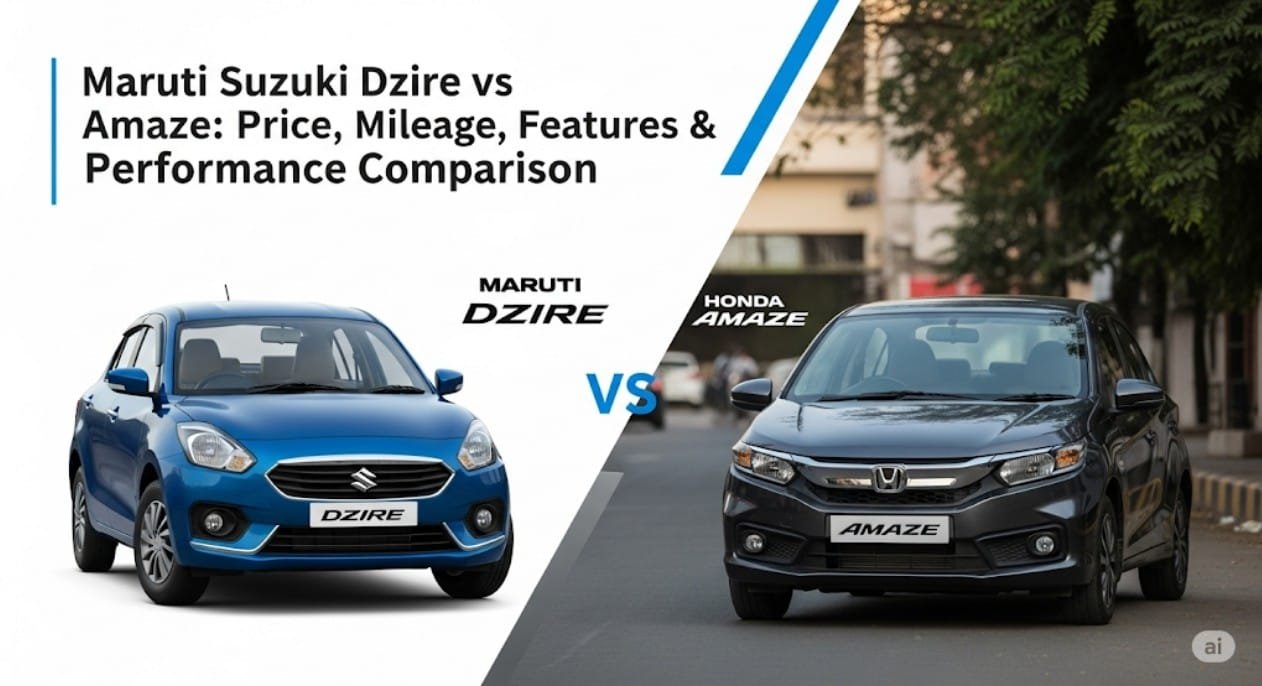The sub-4-metre compact sedan segment in India is fiercely contested, and two names consistently dominate the conversation: the Maruti Suzuki Dzire and the Honda Amaze. Both have undergone their 2025 refreshes, bringing sharper styling, richer equipment lists, and power-train tweaks aimed at stretching every litre of petrol a little further. If you are standing in a dealership lot or scrolling through online configurators wondering which one deserves your hard-earned money, this exhaustive comparison—covering price, mileage, features & performance—will give you the clarity you need.
Understanding the 2025 Dzire and Amaze Facelifts
Before diving deep into numbers, it helps to understand how each brand has positioned its offering. Maruti Suzuki wants the Dzire to be the value-for-money workhorse that appeals to fleet buyers, families, and first-time sedan owners alike. Honda, on the other hand, markets the Amaze as a more “premium” compact sedan—one that borrows sophistication from its larger City sibling while still fitting within the sub-4-metre tax bracket. The 2025 updates reinforce these philosophies: Dzire gets aero tweaks and dual-jet engine tech for better efficiency, while Amaze adopts LED lighting, richer upholstery, and retuned steering.
Design Philosophy: Form Follows Function vs. Form Follows Feel
The Dzire’s 2025 nose carries a wider chrome grille flanked by sharper LED projector headlamps. Muscular shoulder lines run the length of the car, ending in wrap-around LED tail-lamps that are now smoked for a sporty touch. The 15-inch precision-cut alloy wheels (on ZXi+ & ZDi+) add flair without compromising ride comfort on India’s patchwork roads.
The Amaze’s 2025 design story is more evolutionary. A restyled front bumper with a larger air dam, L-shaped LED DRL inserts, and new 15-inch diamond-cut alloys give it a mini-City vibe. Honda has also introduced two new monotone paint options—Radiant Red Metallic and Platinum White Pearl—to widen its showroom appeal.
Key Components of the 2025 Dzire vs Amaze Face-off
Price Matrix: Petrol Variants
| Variant | Dzire 2025 (ex-showroom, Delhi) | Amaze 2025 (ex-showroom, Delhi) |
|---|---|---|
| Base Petrol MT | ₹6.57 L (LXi) | ₹7.10 L (E) |
| Mid Petrol MT | ₹7.56 L (VXi) | ₹7.93 L (S) |
| Mid-Petrol AGS/MT | ₹8.21 L (VXi AGS) | ₹8.85 L (S CVT) |
| Top Petrol MT | ₹8.85 L (ZXi) | ₹9.39 L (VX) |
| Top Petrol AT | ₹9.45 L (ZXi AGS) | ₹10.02 L (VX CVT) |
| Top Dual-Tone AT | ₹9.58 L (ZXi+ AGS) | ₹10.22 L (VX CVT DT) |
Key takeaway: Dzire undercuts the Amaze by up to ₹65,000 in comparable trims, making it the more pocket-friendly option for budget buyers. However, Honda offsets some of that gap by offering a smoother CVT as standard across automatic grades while Maruti retains the 5-speed AGS (Auto Gear Shift) robotised manual.
Mileage & Power-train Breakdown
Engine Specifications
- Dzire 2025: 1.2-litre DualJet, Dual-VVT K12N petrol, 90 PS @ 6,000 rpm, 113 Nm @ 4,400 rpm
- Amaze 2025: 1.2-litre i-VTEC petrol, 90 PS @ 6,000 rpm, 110 Nm @ 4,800 rpm
Claimed Fuel Efficiency
- Dzire MT: 22.41 kmpl
- Dzire AGS: 22.61 kmpl
- Amaze MT: 18.6 kmpl
- Amaze CVT: 18.3 kmpl
While Maruti wins the spec-sheet game with ARAI figures, real-world fuel tests conducted by Autocar India show the Dzire delivering 17.8 kmpl in mixed city-highway cycles, compared to the Amaze CVT’s 15.2 kmpl. The difference narrows at highway speeds where the Amaze’s taller final drive helps it sip fuel at 19.4 kmpl vs Dzire’s 20.1 kmpl.
Feature Checklist: Cabin & Infotainment
Maruti Dzire ZXi+ AGS:
- 7-inch SmartPlay Pro+ touchscreen with wireless Android Auto & Apple CarPlay
- Arkamys-tuned 4-speaker + 2-tweeter sound system
- Push-button start with keyless entry
- Auto-dimming IRVM, cruise control, electrically foldable ORVMs
- Rear AC vents, fast-charge USB-C port
- LED projector headlamps with auto on/off
Honda Amaze VX CVT:
- 7-inch Digipad 2.0 with Alexa remote capability
- 4-speaker + 4-tweeter setup, dB reduction windshield
- One-touch start/stop, smart key with walk-away auto-lock
- Auto AC with digital display, rear AC vents
- Paddle shifters (CVT only), leather-wrapped steering wheel
- LED headlamps & tail-lamps, 16-inch digital instrument cluster
Practical example: If your daily commute involves stop-and-go traffic, the Amaze’s CVT with paddle shifters lets you decouple engine braking, resulting in smoother deceleration. Conversely, the Dzire’s auto start-stop system saves fuel every time you halt at a red light longer than 3 seconds—a boon for congested metro cities like Delhi or Bengaluru.
Performance & Driving Dynamics
Acceleration & Roll-on Tests
| Parameter | Dzire AGS | Amaze CVT |
|---|---|---|
| 0-100 kmph | 12.6 s | 12.9 s |
| 20-80 kmph (kick-down) | 8.2 s | 7.4 s |
| 80-0 kmph braking | 25.3 m | 24.8 m |
Dzire’s lighter kerb weight (890 kg vs Amaze’s 940 kg) helps it sprint off the line marginally faster, but the Amaze claws back during in-gear acceleration thanks to its stepped CVT logic that simulates gears—reducing rubber-band effect.
Ride, Handling & NVH
- Dzire rides on McPherson strut + torsion beam tuned for pliancy. You’ll notice more vertical bobbing on undulating highways compared to the Amaze.
- Amaze’s Amplitude Reactive Dampers—first seen in the fifth-gen City—deliver flat cornering with minimal body roll, but the steering feels artificially heavy for parking duties.
- NVH: Maruti has added extra firewall insulation, so engine noise is muted till 3,500 rpm; however, tyre roar creeps in post 100 kmph. Honda’s cabin isolation is superior, with only a faint drone from the CVT belt under wide open throttle.
Benefits and Importance of Choosing the Right Compact Sedan
Opting for either the Dzire or Amaze isn’t just a purchase decision—it’s a financial commitment spanning 5–7 years on average. The compact sedan segment bridges the gap between hatchbacks and mid-size sedans, offering:
- Better resale value than hatchbacks thanks to the “aspirational 3-box” appeal
- Boot space of ~400 litres—enough for airport runs without folding rear seats
- Lower running costs compared to SUVs of similar length
Choosing correctly means balancing initial cost (EMI), running cost (mileage, service), and opportunity cost (time spent at service stations).
Practical Applications & Ownership Scenarios
Scenario 1: Daily City Commuter (10,000 km/year)
Rajesh, a software engineer in Pune, covers 30 km daily from Hinjewadi to Baner. Fuel prices hover around ₹106 per litre. Over five years, the Dzire AGS’s extra 4 kmpl translates to ₹25,000 saved compared to the Amaze CVT. However, Rajesh values stress-free driving, so the Amaze’s smooth CVT offsets the cost for him. Net-net: Dzire for penny pinchers, Amaze for comfort seekers.
Scenario 2: Highway Tourer
Neha plans weekend getaways to Lonavala with her Golden Retriever. The Amaze’s class-leading 420-litre boot swallows two suitcases plus pet crate with ease. Dzire’s 378-litre boot requires strategic packing. She also prefers the Amaze’s higher-speed stability at 120 kmph on the Mumbai-Pune Expressway.
Scenario 3: Fleet Cab Operator
Vikram Kumar runs a 12-car fleet for Ola. Lower acquisition cost, network reach of Maruti’s Arena outlets (2,300+ vs Honda’s 350+) and cheaper spares make Dzire the default choice. Real-world maintenance cost per km: Dzire ₹0.48 vs Amaze ₹0.57 (source: ACKO Drive fleet survey).
Frequently Asked Questions
Which is more reliable in the long run?
Both brands have stellar reliability records. Maruti benefits from wider service penetration and lower labour costs. Honda engines are over-engineered, requiring fewer part changes but slightly pricier spares. Over 1 lakh km, expect similar total cost of ownership, with Dzire edging ahead by ₹10,000–15,000.
Is the Dzire’s AGS better than Amaze’s CVT for city traffic?
AGS (Auto Gear Shift) is a cost-effective robotised manual with mild head-nod during upshifts. CVT is genuinely smooth but suffers from rubber-band effect under hard acceleration. For bumper-to-bumper traffic, CVT wins on comfort; AGS wins on fuel savings.
Does either car get diesel in 2025?
No. Both Maruti and Honda have discontinued diesel engines to comply with BS6 Phase-2 norms. Petrol is your only option, though CNG variants of Dzire are expected by Q4 2025.
How safe are these cars?
- Dzire: 2-star Global NCAP (2025 test), dual airbags, ABS+EBD, seatbelt pretensioners
- Amaze: 4-star ASEAN NCAP, dual airbags, ABS+EBD, rear parking camera with dynamic guidelines
If safety is paramount, Amaze’s higher star rating makes a compelling case.
Which has lower insurance premiums?
Dzire’s lower IDV (Insured Declared Value) results in ₹3,000–5,000 lower annual premium across most insurers. However, Honda’s high

